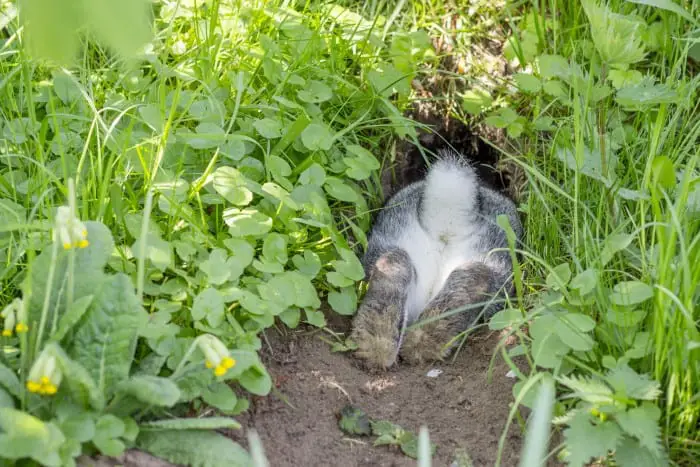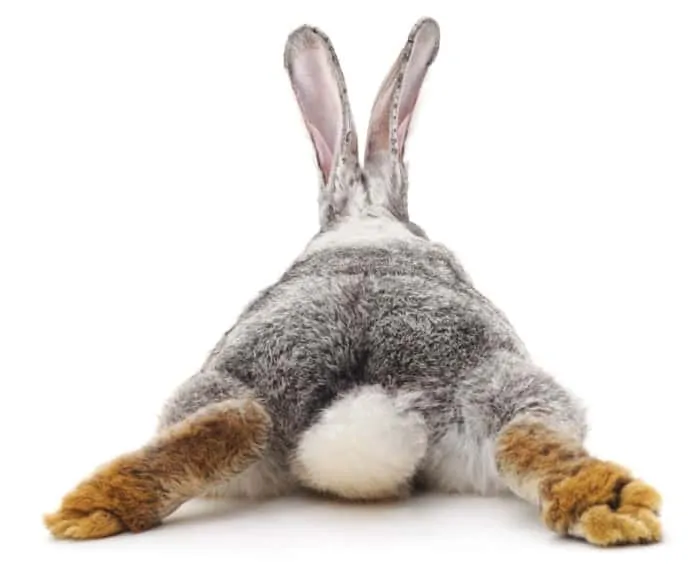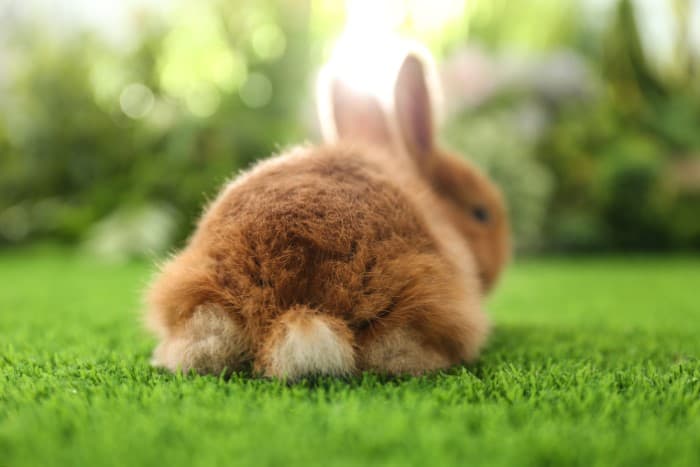A top-rated children’s fable tells us that rabbits have short tails because an alligator bit one when he tried to be tricky. Although this story is far from the truth, it is still surprising how wise nature is when providing each living being with the exact characteristics that each species needs to survive.
You must have already imagined we will be talking about rabbit tails on this occasion. Beautiful, soft, fluffy tails are one of the most distinctive characteristics of rabbits. When we think of bunnies, we immediately imagine a funny little animal with cute long ears and nice cotton ball tails. But have you ever thought about why rabbits have short tails?
What Are Tails?
Let us begin to explain the basics. Tails are flexible appendages found on the back end of many animals; they are an extension of the spine, so they are almost exclusive to vertebrate animals.
Different species of animals have tails of various sizes. Although it may seem that this appendage is useless, in reality, tails are an essential part of the body because they assist in vital functions, such as running, jumping, swimming, and maintaining balance. Many animals even use their tails to communicate and to spice up their mating rituals.
What Elements Makeup Tails?
As we just mentioned, tails are an extension of the spine; therefore, these appendages contain many delicate structures. A rabbit’s tail includes tendons, ligaments, and a small bone. It also has muscles, which allow bunnies to give movement when they need it. There is also a lot of blood flow and nerves, making this area very susceptible and delicate. For this reason, one should be extremely cautious when playing with rabbits.
Any abrupt movement could cause this small bone to break or dislocate, rendering them deep pain. Many rabbits do not like it when someone tries to touch their tails. They will escape at the slightest attempt.

What to Do if My Bunny Hurts Its Tail?
Injuries to rabbits’ tails are not very frequent since they are well protected most of the time. The posture they adopt while sitting down keeps their tail quite hidden, which is why we perceive them as being so small. However, sometimes accidents could happen.
Although a rabbit can live without its tail, injuries can be quite painful, and it is imperative to consult a veterinarian at the slightest sign that the bunny is hurt. This type of damage poses an emergency due to many nerves and blood vessels present in that area. Rabbits’ tails are extraordinarily delicate and could quickly become detached, causing significant problems such as infection and even gangrene, which could compromise the animal’s life.
Why Do Rabbits Have Short Tails?
Although we tend to visualize rabbits’ tails as cotton balls, the reality is that they are a little bigger than they look. They only appear this way because we typically only see the fluffy tail tip coming out from underneath their layers of hair. If you ever see a rabbit stretched out on the ground, you will be able to appreciate the full length of its tail.
As we have seen, everything in Nature has a reason. Each species is different, and each has unique adaptations and traits that have been developed for the sole purpose of survival.
This type of adaptation is what has precisely happened with the tails of rabbits. That little fluffy cotton ball is not just there to adorn and give our pet a sweet, lovely look. Its size and color have a specific purpose. Here is the main reason why.
Tails Assist Bunnies to Escape from Their Predators
Most wild rabbits have short whitetails, or, in their case, their tail fur is light-colored on the underside, which is striking and curious. This pale undercoat is shown when the rabbit runs. Together with the tail’s small size, this color change makes up the perfect feature that helps them escape. Besides, rabbits tend to flick their tails when they run. All this behavior and characteristics have one primary purpose, survival.
Perhaps, common sense would lead us to think that having a white or light-colored tail is an invitation from the rabbit itself so that its predator does not lose sight of it; however, the reality is very different.
A German evolutionary biologist, Dirk Semmann, has discovered that the rabbit’s fur is designed to camouflage itself in the environment. The small, contrasting colored tail functions as a tiny dot that distracts and confuses its predators. Research has shown that a potential predator ignores the animal’s main body by focusing on the tail.
Rabbits can be very cunning and fast. A rabbit can run in a zigzag fashion to get away from a predator and reach speeds of 29 km/h. When the rabbit makes a sharp turn during the chase, this point of focus moves and disappears, forcing the predator to refocus on the animal—needing to refocus on its prey causes the predator to slow down, giving the rabbit extra seconds to escape.
Are All Rabbit Tails White?
Pretty much all wild rabbits will have a white underside to their tail. This feature is the primary defense mechanism they must throw off their predators. However, in domestic rabbits, the coloring of the tail can be a little different.
Although most domestic breeds also have white tails, on occasion, you will find a rabbit who does not. This difference is due to the selective breeding process of domestic rabbits. Most domestic rabbits have been bred specifically to have more unique colors, and this process has affected the tail area as well.
What Other Purposes Do Rabbits’ Tails Have?
Perhaps for domestic rabbits, which are very happy and safe in our homes, survival is not as important a factor, and in that sense, their tails would be useless.
Rabbits’ tails have not only evolved to assist in their survival. Besides their principal function, rabbits use their tails for other purposes. Next, we will discuss the reasons that make these small cottontails so attractive:
To Keep Balance
As in dogs and cats, the tails serve to help the animal keep balance when it is in motion. Although rabbits’ tails are much shorter than dogs or cats, they play an essential role when these animals need to make quick turns. Thus, when a rabbit turns in one direction, its tail will turn in the opposite direction. This mechanism helps the animal to make a faster turn.
As a Way of Communicating With Other Rabbits
Rabbits tails play a vital role in keeping their family safe. They use their tails to send soundless signals to other rabbits or other family members when they need to alert them to danger. This way, they can escape immediately. A bunny can also flick its tail to let the other rabbits in its group know its current position.

To Show Emotions
One way to understand what our rabbits are trying to communicate is to learn to understand their body language. They can make themselves understood in different ways, and one of them is through the movements of their tail. Let us look at the following examples:
- Boredom: Rabbits are intelligent and friendly animals. They need plenty of exercises and mental stimulation. A bored rabbit will repeatedly try to chase its tail.
- Curiosity: a curious or cautious rabbit will often crawl forward on their front paws while their back feet and tail are stretch out long behind them. The tail will be angled down toward the ground as a way of showing that they are not confident right now.
- Anger: an aggressive bunny will raise its tail as they lunge forward or growl. An incredibly angry rabbit, or one who is looking to mate, will even flick their tail back and forth a little.
- Irritability: one way to know if your rabbit is irritated by any situation is by the movement of its tail. Unlike dogs who wag their tail when they are happy, rabbits wag their tail when they dislike something.
Peeing
Rabbits will lift their tail as they pee. This behavior is a way to ensure that their tail does not get wet and the fur does not get matted from the pee. This behavior can be advantageous when we are potty training our rabbit since it allows us to lift it and move it to the right place where it should go.
As you will have been able to see, this little tail, which at first sight seems not to have much importance, plays a vital role in the life of our rabbits.
Rabbit’s tails have fascinating peculiarities. Tails are a part of the body that makes the rabbits look cute and have an importance that not many know.
For our pet rabbit, its tail may not be so useful when it comes to survival. Still, it is essential to establish communication with its owner or any other animals with which it coexists. Learning to understand your pet’s body language, and the way it uses its tail to communicate is a way to understand our pets a little better.

